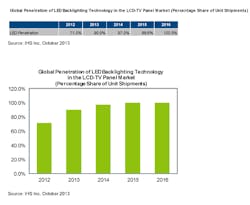With the market for LED backlighting stabilizing, sellers of LED technology are looking to new lighting markets for growth over the next few years. LED lighting in general is a bright spot on the economic horizon, but industry researchers point to the market for packaged LEDs in residential lighting as a particularly hot area over the next three years.
“Amid falling prices and rising consumer acceptance, light-emitting diode (LED) technology is taking over the lighting business, spurring a 96% increase in packaged LED revenue in the market from 2013 through 2016,” according to a late 2013 report from market researcher IHS Inc. A packaged LED is an LED die that has a protective covering with contacts that allow it to be directly soldered to an electrical circuit.
IHS predicts global revenue for packaged LEDs used in lighting applications to reach $7 billion in 2016, up from approximately $3 billion last year.
In recent years, growth in packaged LEDs was centered on the market for LCD backlighting, in applications such as mobile phones, notebook computers, and televisions. Those applications have completed their transition to LED technology for the most part, stabilizing demand and limiting growth to single-digit percentages, IHS says. In a separate 2013 report, the researcher said LED backlighting was set to reach 90% penetration in LCD TVs in 2013, for example (see the figure).
Such changes open the market to more general lighting applications, which IHS predicts will “provide the next wave of explosive growth for packaged LEDs.”
“In 2012, the lighting sector became the largest end application for the packaged LED market, having finally overtaken the TV backlighting market,” the researcher reports. “Market saturation for LED backlighting has resulted in a number of leading suppliers shifting their focus and development resources toward the lighting industry.”
Competition Heats Up
Many companies focused on LCD backlighting have already begun their shift to lighting.
“LED suppliers that are focused on lighting are predicted to gain market share,” says Jamie Fox, principal analyst for LEDs at IHS. “Some of the companies that have a large market share in LED backlighting, such as Seoul Semiconductor and Samsung, have already managed to shift much of their business to lighting and have done very well in this area, winning market share in recent years.”
Increased competition will result, which researchers say will drive down prices in the LED market over the next four years. IHS forecasts average selling prices for packaged LEDs in lighting to fall to $0.19 in 2018, down from $0.25 in 2016 and $0.41 in 2013, for instance.
Residential lighting applications represent the greatest growth opportunity ahead, IHS says, predicting packaged LED revenue in that sector to grow to nearly $2.7 billion in 2016, up from roughly $850 million last year. Retail and hospitality markets have led LED lighting adoption in recent years, at approximately 6% penetration. Comparatively, the residential market is at about 1% penetration—but primed for growth. Geographically, IHS says Japan saw the largest adoption of LED lamps in 2013.









